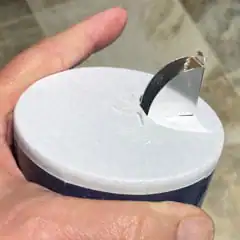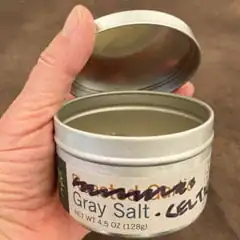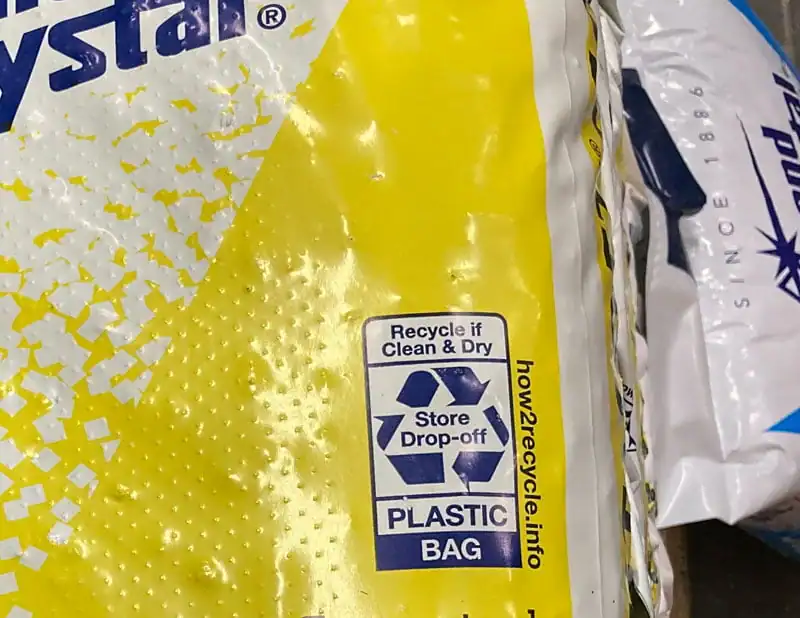The containers that salt comes in can sometimes make people wonder if they can be recycled, and if so, how? In this article I explore recycling salt bags, buckets, those special cardboard drums and other containers that salt come in. I will delve into the recycling process, the challenges associated with salt container recycling (especially those big plastic bags), and the alternatives for proper disposal.
Whether you’re an environmentalist or just looking for ways to reduce waste and do the “right thing”, this post will provide valuable information on the topic of salt container recycling.
Can Salt Bags Be Recycled?
In general, salt bags can be recycled, but the process can vary based on the type of material used to make the bags. Most salt bags are made of plastic materials such as polyethylene, which can be recycled in the right circumstances.
Another big factor is where you live. I fortunately live in an area that is dedicated to the Zero Waste initiative, so we have convenient means to recycle a wide range of items, including “hard to recycle” categories. Check the guidelines and restrictions of your local recycling agency. While salt bags may not be able to be placed in your container for weekly pickup, many communities are starting to have drop-off centers for items that are possible to recycle when they are separated from the “single stream” recycling.
To recycle salt bags, be sure to completely empty any remaining salt and give the bags a rinse inside with the garden hose or in your laundry sink. This ensures that the recycling process is not contaminated and the plastic can be effectively processed. Once the bags are clean and dry, they can enter the recycling stream via the correct method specified by your recycling provider.
What About “Store Drop Off”?
So I explored that website shown on the label of the salt bag in the featured image for this article: how2recycle.info There is no search feature visible on the site and I could not anywhere find a link or FAQ that told be how to find the list of participating stores in the United States. That seems to me like a set of information that would be of FREQUENT interest.
As a result, I did some deeper searching and found this PDF listing participating store from the same website, but you’ll need my link to easily get there: participating film and bag recycling partners
The stores and .ORG businesses listed on the PDF in my area are a reasonable set of places that would find value in participating, so hopefully this is a good list for salt container recycling in your area.
What if My Salt Bags Can’t Be Recycled?
Perhaps you buy a brand of salt where the plastic bag has no recycling information. What should you do?
- Change Brands – My first response would be to change my salt brand to one where the manufacturer cares about the waste stream. Whether you are using Pool salt, Water Softener salt, Deicing salt or some other bulk salt product, you do have choices. In my mind, a product manufacturer that cares about recycling might also care more about producing a quality product. That’s just an opinion, but maybe it rings true with you, too.
- Change Types – Sometime you can choose a bulk salt product that comes in a recyclable bucket instead of a plastic bag. The buckets can be repurposed for use in the garden or for storing items. Water Softener salt is sometime available in a big solid block – it doesn’t need a container. Problem solved.
- Check With Your Local Recycling Resource – Local recyclers know A LOT about containers and which ones they can take, despite the label or lack thereof.
- Repurpose – At last resort, you could repurpose the salt bags as garbage bags and buy fewer plastic bags for that purpose. As I said, last resort …
It’s important to check with your local waste management facility to determine the best disposal method for salt bags in your community. Proper disposal is important for protecting the environment and ensuring that waste is managed safely and sustainably.
Other Salt Containers
Beyond large plastic bulk bags, packaged salt comes in some well known, even “classic” packaging. Let’s look at salt container recycling for those items.
Classic Salt Drum Container
Salt has been sold in a drum-shaped paperboard container for so many years that it has become a classic. That type of container falls in the “mostly recyclable” category. Here’s how to do it:
- Completely empty the salt from the container
- Grab onto the little metal spout on top and pull it off. If you have metal recycling at your “hard to recycle” center, the spout can go in that bin. Don’t put it in your “single stream” bin because small pieces of metal like this can get lodged in recycling sorting machines and cause problems
- Now that the spout is gone, stick a finger in the top and break it to the edge of the paperboard cylinder. That may allow you to pour out just a little more salt.
- Peel any plastic labels (if present) off of the container and throw those in the trash.
- Important: Tear the edge of the paperboard drum – if it just tears, the drum is recyclable. If you see evidence of plastic or if it is lined with a material that stretches, the drum is NOT recyclable.
- Recyclable paperboard drums can go in your paperboard recycling – and into mixed single stream recycling if paperboard is supported.

Cylindrical salt drums are still widely available and can be one of your most accessible means of being able to achieve a high level of salt container recycling.
Paperboard Boxes
Products like Maldon Salt come in paperboard boxes with a cellophane bag inside. The paperboard is recyclable in most areas. The cellophane goes in the trash.
Kosher salt can often come in thick paperboard boxes with the top and bottom throughly glued shut. While it can be a little hard to get the top open on these boxes, the beauty is that the entire container is recyclable in most areas.
Metal Tins with Lids
If you can find salt in a nice metal tin with a lid, BUY IT! While the metal containers are completely recyclable, you won’t want to do it. The tins are just too nice for storing kitchen supplies – or craft supplies – or whatever!
I got a set of flavored sea salts years ago from a place called Napa Style in St. Helena, CA many years ago. Sadly, they don’t seem to be in business any more, but I am still reusing their wonderful salt tins. The tins stand up to the corrosive nature of salt perfectly and are air tight while the lids are still easy to take off and put on.

Bonus Idea: Tins like this are perfect for storing seeds. Harvest your California Poppy or Morning Glory seeds and protect them in these tins until next spring!
Hard Plastic Container
Plastic canisters that are made of a combination of different plastic materials often cannot be recycled. Plastic containers using a single type of plastic have a higher chance. This is true no matter what product is in the container, not just salt container recycling.
Once again, look at the package for information. The larger volume manufacturers are getting better at package labeling. Be sure to follow the guidelines and rinse your container.
Given that salt is readily available in non-plastic containers, consider “pre-cycling” by choosing a more environmentally friendly container to up your level on salt container recycling.
Plastic Salt Buckets
Since most plastic salt buckets are made of a type of plastic called polyethylene, they can be recycled. The “chasing arrows” number will be 1, 2 or 4, depending on the type of polyethylene, but buckets tend to be high-density (#2).
Once again, completely empty the container, and rinse both the bucket and the lid. When dry, add the bucket to the correct recycling stream for your area. If the handle is made from metal, removing it can improve the ability for it to be recycled. Note that sometimes the lids are not accepted by recycling centers even when they will take the bucket.
Smaller Plastic Bags
When buying culinary salt, it is common to get it in a plastic bag. One of the basic recycling rules is that single material containers are more recyclable than containers that are made from a number of materials. Fancy packaging for marketing a product makes the packaging less recyclable: think about those “zip top” bags and super-shiny mylar packaging.

An example of a small plastic bag that contains salt. This plastic bag is recyclable. See the “stretch test” below.
As with all salt containers, throughly empty the bag, rinse out any residual salt, and peel off any adhesive labels if you can.
Plastic Film Stretch Test
“Plain ole” plastic bags often can be recycled. I learned a trick from my local recycling facility one day when I was dropping off a load of plastic film recycling. The women sorting through the incoming bags told me that if you stick your finger into a bag and the material stretches, generally the plastic tends to be recyclable. If you stick your finger in the bag and it breaks – or if you can’t get the plastic to move at all, it generally is NOT recyclable.
Frequently Asked Questions
Are Salt Bags and Canisters Considered Single-Use Plastics?
Salt bags and plastic canisters are typically classified as single-use plastics since they are meant to be used once before being thrown away. Some responsible manufacturers are trying to address the issue of salt container recycling – and I like to buy my products from them. A few people have found ways to either recycle or up-cycle these items, but for the most part many plastic salt containers don’t get recycled (even it if is possible to do so) and become waste that ends up in landfills.
Are Salt Bags and Canisters Safe To Reuse?
In general, salt bags and canisters are safe to reuse if they have been properly cleaned and dried before being used again.
Can Salt Bags and Canisters Be Composted?
While you should “never say never”, I’ve never seen a compostable salt container. No plastic of any kind should go into your compost or into community compost collection.
Are There Any Eco-Friendly Alternatives to Salt Bags and Canisters?
As mentioned above in this article, there are lots of choices for most salt products you’d like to buy. The most eco-friendly means of selecting a product is to pick one that comes in a container that you know you can recycle in your area.
Are non-working Salt Grinders recyclable?
Usually no – because grinders are made from many different materials. If you can separate the salt chamber from the grinding mechanism, that part can often be recycled if it is glass or clear plastic (such as #1, #2). The grinder top has to go in the trash.







